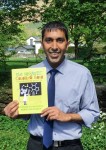Midway through his newly published book, Neil Garg poses a serious scientific question to his reader.
“What’s a chemical in coffee that adults like so much?”
The question is scrawled in chunky cartoon letters inside the children’s coloring book he created. An answer awaits on the opposite page: caffeine, a stimulant, its molecular structure rendered in black and white.
Garg, a professor of chemistry and biochemistry, said he was inspired to write and self-publish The Organic Coloring Book with the help of his two young daughters. Garg released the kid-friendly book April 22, hoping it would inspire children to love organic chemistry as much as he does.
When his younger daughter Kaylie was 4 years old, she began questioning her parents incessantly about the chemicals served in her food, Garg said.
“Kaylie had a fear of chemicals,” said Garg, who is also a faculty-in-residence at De Neve Gardenia and Holly. “She was really skeptical.”
So, Garg and his wife began teaching Kaylie that everything around her was filled with chemicals. These important substances, such as cyanidins and beta-carotene, made her blueberries blue and her carrots orange, Garg would tell his daughter. Eventually, he said, chemical naming became a game around his house. Kaylie’s older sister, Elaina, also joined in on the fun.
The game of chemistry soon reacted with his teaching career to produce the coloring book idea.
“The word ‘organic’ has a lot of definitions these days,” Garg said. “For example, ‘organic’ can mean ‘minimal use of pesticides.’ (But) to an organic chemist, the definition is very different: ‘molecules made up of carbon and hydrogen atoms.’”
Kaylie and Elaina helped Garg select the molecules for the book. Then he asked a graphic artist to create a little character that would follow the reader on every page of the learning journey: Cheesy, a cartoon mouse.
Emma Baker-Tripp and Joyann Barber, graduate students in Garg’s research lab, pitched in by constructing and optimizing the chemical structures used for the book. They made sure every molecule’s atoms and bonds were visible using the computer programs Spartan and CYLview, said Baker-Tripp, a graduate student in chemistry.
When the book was finally ready to publish, Garg gave away more than 100 free copies to the UCLA Krieger Center and Warren Avenue Elementary School. The children in his daughter’s fourth-grade class helped distribute some of these copies to their kindergartener friends, he added.
This past weekend, the family gave away more copies at a school event called the Warner Science Slam.
“Everybody’s been super positive about it,” Garg said. “Kids love to color; they’ll color anything.”
Earlier this week, Garg accepted the Royal Society of Chemistry Higher Education Teaching Award for his accomplishments in popularizing organic chemistry and innovating chemical education, according to the society’s website. Garg has received multiple awards throughout his teaching career, including recognition for his program Biology and Chemistry Online Notes, an online organic chemistry learning system now used in curricula across multiple states.
[Related: Reel Life: Neil Garg]
Garg said he now hopes local museums or the UCLA Store hear about his coloring book and will be open to distributing it. Some of his students are interested in penning a second volume, he added.
“I think there’s been a need in general to have research programs give back to the community,” Garg said.
